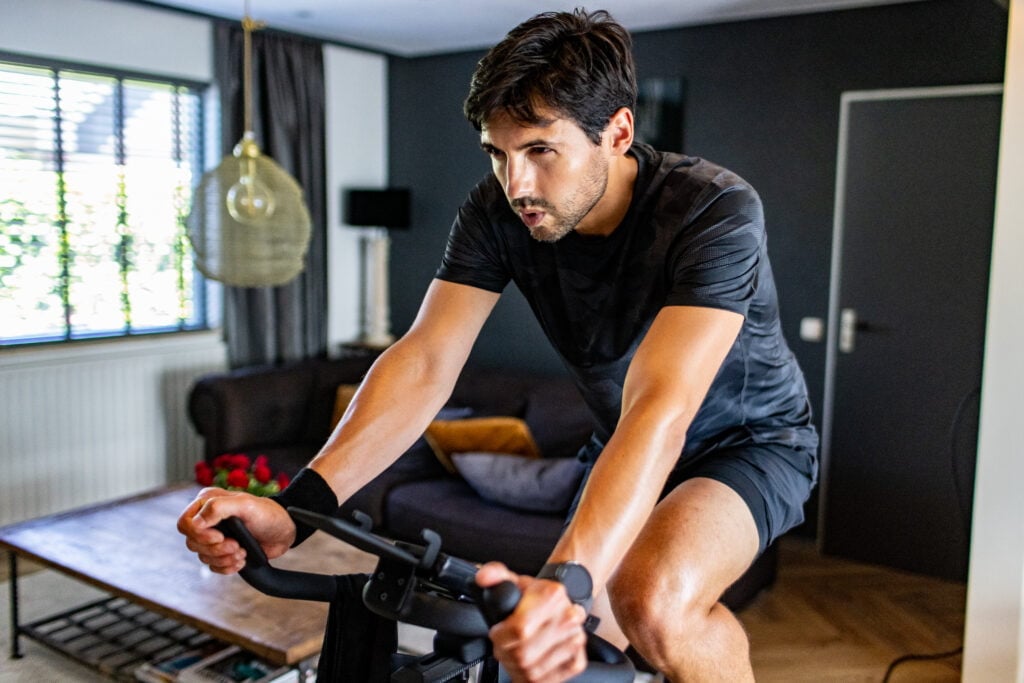Indoor Cycling Mistakes: Avoid these 6 common Errors

Are you ready to take your indoor cycling game to the next level? Discover the 7 common Indoor Cycling mistakes that you absolutely must avoid before, during, and after your workout. Learn how to set up your bike correctly, apply the right techniques, and prevent injuries. Keep reading!
Inhoudsopgave
Bike Setup: Optimize Your Workout
A successful indoor cycling workout starts with a well-adjusted bike. This is one of the mistakes in Indoor Cycling that are easy to avoid. The correct height of your bike seat and handlebars is crucial. Improperly adjusted saddle height can lead to knee and back problems, while a seat that’s too high can hinder the efficiency of your pedal stroke and cause tension in your hips.
Incorrect bike adjustment can cause various issues such as knee pain and overuse injuries. Moreover, incorrect handlebar height can lead to tension and discomfort in your neck, shoulders, and wrists in the long run.
It’s essential to take the time to properly adjust your bike before you begin your indoor cycling session. Ensure that your saddle is at the right height so that your leg is almost fully extended at the bottom of the pedal stroke with a slight bend in the knee. The handlebars should be at a height that allows you to sit comfortably with your arms resting relaxed on the handlebars.
By adjusting your bike correctly, you create an optimal riding posture, improve power transfer, and minimize the risk of discomfort and injuries. Experiment with different heights to find the ideal position that suits your body and comfort level. This way, you can maximize your performance and enjoy every ride without unnecessary aches and issues.

Incorrect Posture: Find Your Balance
A proper sitting position is essential for a successful and comfortable indoor cycling workout. In addition to distributing your weight between the saddle and the pedals, there are two key aspects to focus on: the position of your elbows and avoiding drooping wrists.
While cycling, it’s important to turn your elbows inward and keep them close to your body. This provides more stability and control over the bike. Allowing your elbows to point outward can lead to instability and the risk of losing balance during intense sessions. So, keep your elbows pointed inward and feel the stability as you apply power to the pedals.
Another common mistake is letting your wrists droop. This can cause discomfort and injuries such as wrist pain or carpal tunnel syndrome. To prevent this, it’s important to keep your wrists in a neutral position, straight with your forearms. This helps reduce tension and stress on the wrists and provides a more ergonomic and comfortable sitting posture.
By paying attention to your sitting posture, with inward-pointing elbows and neutral wrists, you establish a strong foundation for smooth and powerful movement during indoor cycling. Remember that good posture not only improves your performance but also helps prevent injuries, allowing you to enjoy your workouts for longer.
Incorrect Pedal Technique: Push and Pull
To optimize your training during indoor cycling, it’s important to make full use of your pedals. It’s not just about pushing the pedals down; it’s also about pulling your feet up to generate maximum power. By exerting both downward and upward force, you activate more muscle groups and optimize your effort.
One of the common indoor cycling mistakes is to secure your feet on the pedals and only push without pulling your feet up. This not only limits your ability to generate power but can also lead to overloading your knee joints and muscle fatigue.
Furthermore, it’s crucial to keep your feet and ankles relaxed while cycling. If you tense your toes too much, you may experience cramping and discomfort. Maintain a relaxed foot position and evenly distribute pressure across your feet.
With the right pedal technique, where you both push and pull, and by maintaining a correct foot position, you not only improve your performance but also reduce the stress on your joints.
Excessive Resistance: Build Up Gradually
One of the most common indoor cycling mistakes is starting with excessive resistance right away. While it may be tempting to begin with a challenging resistance, it’s important to build up gradually. Always start with light resistance and allow your body to adapt to the motion and intensity of the workout. As you become stronger and increase your endurance, you can gradually raise the resistance.
Gradually building up resistance has several benefits. Firstly, it helps prevent injuries and muscle overuse. Starting with light resistance allows your muscles to adapt to the effort and the pedaling motion, reducing the risk of overuse or muscle soreness.
Secondly, gradually increasing resistance allows you to improve your technique and posture. Starting with light resistance enables you to focus on finding the right cadence and maintaining proper form. Over time, you can incrementally raise the resistance and challenge yourself to become stronger and fitter.
Remember that the goal of indoor cycling is to gradually build your strength and endurance. Avoid pushing yourself to the extreme right away, but give your body time to adapt. Listen to your body and increase the resistance step by step at a pace that is comfortable and challenging for you.
Inadequate Hydration
One of the last Indoor Cycling mistakes: Inadequate hydration. Hydration is crucial during your indoor cycling workout. During an intense training session, you lose a lot of fluid through sweat, which can lead to dehydration if you don’t drink enough. Proper hydration is essential to maintain your performance and reduce fatigue. Drinking water also helps regulate your body temperature and transport nutrients to your muscles.
To ensure you stay well-hydrated, it’s advisable to start hydrating before your workout. Drink about 500 ml to 1 liter of water within the hour before your indoor cycling session. During the training, it’s important to drink small sips of water regularly, preferably every 15-20 minutes. Keep a water bottle handy and ensure easy access to water.
No Cooling Down: Give Your Body the Rest It Deserves
A cooling down is an essential part of every workout, including indoor cycling. This is also one of the Indoor Cycling mistakes that are easy to avoid. After an intense effort, it’s important to give your body time to gradually cool down and return to a resting state. A cooling down helps lower your heart rate gradually, allowing your blood circulation and breathing to return to normal. This process ensures that your body recovers gradually from the effort and prevents sudden drops in blood pressure, which can cause dizziness.
In addition to lowering your heart rate, a cooling down has other benefits. It helps flush out lactic acid and other toxins that have accumulated in your muscles during the workout. By stretching your muscles during the cooling down, you promote flexibility and improve blood circulation, which speeds up the recovery process.
A good cooling down can also help reduce muscle soreness. By stretching and relaxing your muscles, you reduce the tension built up during the workout. This can help alleviate the stiffness and pain that often occur after an intense training session. By regularly incorporating a cooling down, you can promote your body’s recovery and ensure that you’re ready for another challenging workout next time.
We’ve provided a brief cooling-down routine below that you can follow after your cycling workout.
Avoid These Indoor Cycling Mistakes
By avoiding these common mistakes in Indoor Cycling and making the right adjustments, you can elevate your workout to the next level. Optimize your bike setup, find balance in your posture, improve your pedal technique, gradually build up resistance, ensure adequate hydration, and don’t forget to cool down. This way, you can prevent injuries, train more efficiently, and fully enjoy every indoor cycling session.
